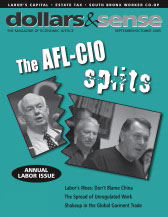A Split That May Mean More Labor Unity
This article is from the September/October 2005 issue of Dollars and Sense: The Magazine of Economic Justice available at http://www.dollarsandsense.org

This article is from the September/October 2005 issue of Dollars & Sense magazine.
Subscribe Now
at a discount.
There's been plenty of hand-wringing over the supposed loss of labor unity in the wake of the AFL-CIO split. While AFL-CIO headquarters will take in a few million dollars less in dues--a tiny fraction of the billions of dollars the labor movement spends each year--it's not clear what else will be that different in relations between the two union blocs.
Will there be more fights between unions to organize the same workers? Possibly, although AFL-CIO unions have been fighting each other state-by-state for decades to represent the same public sector workers, multiple unions have fought to represent the same workers at hospitals across the country, and the Communication Workers of America and UNITE-HERE have been in an ongoing fight to represent casino workers in California, to name just a few of the ongoing jurisdictional battles. So it's not clear how much more competition is likely to happen beyond what we've already seen.
Will political unity be lost? In the 2004 election, unions were bitterly divided in the primaries between different Democratic candidates and, while they almost all supported John Kerry, different unions spent much of their electoral money through their own political vehicles: SEIU supported the group America Coming Together, AFSCME promoted an alternative "527 committee" called Voices for Working Families, and all unions operated substantially through single-union political committees. So electoral cooperation has always been more on a case-by-case basis than through any permanent institutional unity of political operations.
Will unity at the local level be lost? John Sweeney swore at the AFL-CIO convention that unions disaffiliating at the national level would be barred from participation in local and state labor councils. But within weeks of the split, he was backpedaling under pressure from AFL-CIO locals and offered disaffiliated unions the option of participating in those local bodies under so-called solidarity charters. While the particular deal was not seen as that attractive to the disaffiliated unions, it reflects a shared desire to find ways to work together one way or another. If working through official local labor bodies doesn't pan out, there are already a number of labor-backed local non-profit groups--such as Working Partnerships in Silicon Valley and the national Jobs with Justice network--that will likely become vehicles for formal cooperation between unions in and out of the AFL-CIO.
So if fears about lost unity are overblown, what are the potential gains from the split? At some level, I subscribe to the idea that almost anything that stirs up new energy in the labor movement is good. The split has forced labor leaders on all sides to engage in more strategic thinking than we've seen in decades, so that's a gain all by itself.
And if the new Change to Win unions actually begin cooperating in fundamentally new ways, the results for workers in those industries could be profound. There was a taste of that promise in the immediate wake of the AFL-CIO convention when all of the Change to Win unions pledged to back Houston and Indianapolis janitors who had organized innovative sympathy strikes among other janitors in cities around the country in earlier weeks. Brian Rainville of Teamsters Joint Council 25 in Chicago announced that if the janitors reestablished picket lines in Chicago, the council would sanction those strike lines for its more than 100,000 members. This was a major escalation of the threat janitorial companies faced if they resisted the demands of janitors in Houston.
The results of both the janitors' solidarity and the support of the other unions were dramatic. Within weeks of this solidarity statement by the Change to Win unions, five janitorial contractors in Houston agreed to recognize the union if a majority of workers signed cards requesting it, and agreed not to campaign against the union or otherwise discourage workers from joining. This means that 6,000 building service workers in Tom Delay's back yard will likely have a union within a few months, highlighting the possibility of organizing workers even in the South when unions practice real solidarity.
I would wager that the unions left in the AFL-CIO will react to the split by tightening their organizing focus and solidarity in similar ways. It's worth remembering that in the wake of the old CIO split in the 1930s, it was the AFL that, in response, ended up organizing more workers in the following years.
Two blocs of more tightly unified unions are likely to be more successful in coming organizing drives than the more diffuse solidarity that existed before the split. There will no doubt be bumps in the road ahead, but I predict that organizing will be the winner in the end.
